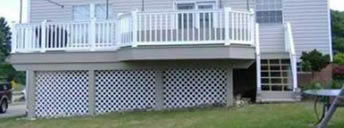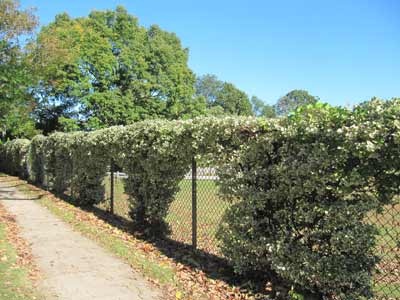-
CART
0
Shopping Cart
Once upon a time, the careful angles of a lattice and the playful curves of a vine met on a garden trellis. This attractive pair resulted in more than a mere source of outdoor decor, however. They created an effective and attractive screen that can hide unwanted sights from view or create privacy.
Trellises are excellent vertical gardening structures because they help expose a vine's leaves to more sunlight. Some fruits and vegetables are actually most productive when supported by a trellis. Grapes, tomatoes, beans, cucumbers, peas, smaller varieties of gourds, squash, and pumpkins all benefit from vertical supports.
Most trellises are two-dimensional structures of one or more lattice patterns. Some stand alone, while others are attached to buildings. And since fences involve many of the same lattice patterns as a trellis, fences should also be considered an excellent backdrop to many decorative and edible plants.Trellis Under Deck Properly chosen vines can really dress up an otherwise plain fence material such as chain link fence. To have gardening success with trellis and fence, there are a few things to it is helpful to know.

How Vines Cling
Vines use different strategies to do their climbing. Some have tendrils, while others have coiling leaf stalks, twisting or twining stems, or weaving stems. Among roses, for instance, there are ramblers and twiners. The branches of ramblers grow in a weaving pattern in and out of lattice. Climbing roses twine around the lattice. A few determined vines such as Virginia creeper can even cling to solid vinyl fence with their natural adhesive "feet." Some clinging vines, such as climbing hydrangea, have aerial roots that lightly penetrate porous surfaces such as wood or brick.
These methods of clinging and climbing, plus the potential weight of a full-grown vine, create a range of choices you should consider before planting.

Criteria for Selecting Vines
Maintenance of the fence: You should base vine selections on the type of fence.
Annual plants and herbaceous perennials die back to the ground every fall. If your trellis or fence is painted every few years, annuals such as morning glories or herbaceous perennials such as golden hops are good choices. After they die back, you’ll have a period of months to paint, clean, or repair the structure.
If the trellis or fence is natural weathered (unpainted) wood, chain link, or vinyl, it is a candidate for woody perennials such as hardy kiwi, climbing hydrangea,roses, grapes, and euonymous. All of these lose their leaves in the winter but the trunks and stems persist. There are a few evergreen perennial vines, such as the shade-tolerant Persian ivy.
Height and spread of the vine: Think about the size of the mature vine before you plant. Annual vines such as sweet peas or climbing nasturtium grow to about 6’, while the perennial Virginia creeper can grow to 30’ long and 10’ wide.
Trellises add a wonderful visual touch to all types of landscapes. With a few simple choices, you can create both privacy and beauty by covering them with vines. Since it may take a few years for woody perennials to cover a structure completely, try mixing annuals and perennials in the first few years. That will help create color and cover right from the start.

For more information on Penn Fencing products, please visit our online store.
Please contact us if you are interested in obtaining information on our professional fence, vinyl decking or railing installation services by clickling on the button below.
CONTACT US >






